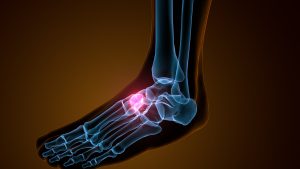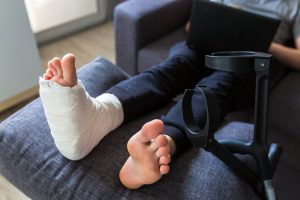Foot injuries can occur in various ways and at different locations, such as accidents at work or road traffic accidents. For example, you may have been at work carrying a heavy load when you slip and fall, causing a tear to your Achilles tendon and resulting in a loss of mobility. You may be entitled to compensation for this type of injury. As such, a foot injury claim calculator may help you understand how much compensation you could be eligible for.
Our guide aims to discuss:
- How to claim for a foot injury
- Who may be responsible for your foot injury
- How much compensation you may be awarded in a successful claim
- How our panel of solicitors could help you claim compensation with paying solicitors’ fees upfront
If you have any questions while reading this guide, or if you would like to find out if you are eligible to claim compensation, speak to a member of the advisory team. They are available around the clock to discuss personal injury claims and can provide you with a free consultation, which will look at your eligibility and how much you could claim.
To speak to an advisor about your foot injury compensation claim:
- Call 0800 408 7826
- Use our built in livechat feature
- Make a free claim enquiry with our online form

Frequently Asked Questions
- Foot Injury Claim Calculator
- How Is Foot Injury Compensation Calculated?
- Who Can Claim Compensation For A Foot Injury?
- The Most Common Foot Injury Accident Claims
- How Can A Foot Injury Impact Your Quality Of Life?
- How To Start A Foot Injury Claim
- Get Free Advice On Our Foot Injury Claim Calculator
- Learn More
Foot Injury Claim Calculator
If you have experienced a personal injury, you may be wondering how much compensation you could receive. Using our foot injury claim calculator will give you a rough idea of the amount of compensation you could be entitled to.
Our table below outlines the Judicial College Guidelines (JCG), which offer guideline brackets of injury types and severity. It is the same document that we used to put together our compensation calculator.
Professionals will make reference to these guidelines when determining your compensation amount. Please note that these are only guideline amounts, and the top figure has not been taken from the JCG.
| Injury | Notes | Compensation Guideline |
|---|---|---|
| Multiple Serious Injuries + Special Damages | Multiple severe injuries and financial losses such as loss of earnings. | Up to £500,000 or more |
| Amputation of Both Feet | Due to loss of ankle joint, this bracket is a similar range as that in below knee amputation. | £206,730 - £245,900 |
| Amputation of One Foot | Due to loss of ankle joint, this bracket is a similar range as that in below knee amputation. | £102,470 - £133,810 |
| Very Severe Foot Injury | Cases in this bracket must have continuous pain or permanent disability, such as significant loss of the heel impairing mobility. | £102,470 to £133,810 |
| Severe Foot Injury | Fractures of both heels or feet causing an impact on mobility or considerable and permanent pain. The bracket may include injuries alike to a single foot. Examples can include osteoporosis or any disability restricting the usage of the wearing of normal shoes. | £51,220 to £85,460 |
| Serious Foot Injury | This bracket includes injuries less severe than that above but leading to continuing pain from traumatic arthritis or the risk of future arthritis. | £30,500 to £47,840 |
| Moderate Foot Injury | Displaced metatarsal fractures causing permanent deformity and ongoing symptoms. May also pose a risk of osteoarthritis and/or future surgery. | £16,770 to £30,500 |
| Modest Foot Injury | Cases will include simple metatarsal fractures, ruptured ligaments, or puncture wounds. | Up to £16,770 |
| Severe Post Traumatic Stress Disorder | Cases include permanent effects which prevent the injured person from working or functioning at the pre-trauma level. | £73,050 to £122,850 |
| Moderately Severe Post Traumatic Stress Disorder | Cases will show some recovery with mental health, but are still likely to cause significant disability for the foreseeable future. | £28,250 to £73,050 |
How Is Foot Injury Compensation Calculated?
Foot injury compensation is calculated using frameworks such as the JCG, which we refer to above, as well as considering similar previous cases and other documentation, such as your medical records.
When calculating your compensation amount, professionals will consider two heads of claim. These heads of claim are known as general and special damages.
General damages will compensate you for the physical and psychological pain you have endured due to your injury. This can include things like:
- Pain and suffering from the foot injury
- Loss of amenity – so any loss of enjoyment of life, including the loss of ability to engage in hobbies
Special damages, however, will account for financial losses incurred from your injury. This could include:
- Loss of earnings
- Medical costs, such as wheelchairs or mobility aids
- Travel costs
In order for you to be able to claim special damages, you must also obtain evidence to prove the financial losses you have suffered. This could be things like:
- Invoices
- Paylsips
- Receipts from travel costs
The purpose of compensation is to financially recompense you for the losses you have experienced because of your foot injury. Special damages aim to put you in a similar financial position to the one you were in before your foot injury.
We understand that personal injury can have detrimental effects on you, and our panel of solicitors will advocate on your behalf to obtain the best settlement for you. Contact us today to learn how we can assist you.
Who Can Claim Compensation For A Foot Injury?
In order for you to be eligible to claim for a foot injury, three things must be proven:
- You were owed a duty of care
- This duty was breached
- The breach led to your injury
If all three components are present, negligence can be established.
If negligence can be proven, then you have the basis for a personal injury foot claim. Contact our team today to see how to start your claim for a foot injury. In addition to checking your eligibility, an advisor can also explain how to use our foot injury claim calculator.

The Most Common Foot Injury Accident Claims
Foot injuries can occur in various places and circumstances. Below, we will discuss the most common ways that a foot injury can occur, and who owes you a duty of care in these situations.
Road Traffic Accidents
Road traffic accidents are a significant cause of personal injury. While using the roads, all road users owe a duty of care to one another. This duty of care is to take reasonable care whilst using the roads to avoid harm or danger to other road users. To fully comply with this, road users must adhere to the rules and regulations found in both the Road Traffic Act 1988 and the Highway Code.
If you have been involved in a road traffic accident, whether this be a car accident or an accident as a pedestrian, cyclist or motorbike rider, which directly caused your foot injury, you might have grounds for a personal injury claim. Contact us today to learn how we can assist you in starting your claim.
Accidents At Work
The Health and Safety Executive (HSE) reported that from 2023 to 2024, there were 604,000 non-fatal injuries sustained at work. The HSE is responsible for monitoring the health and safety of workplaces in Britain.
Accidents at work can occur in a range of different ways, for example, through slips, trips, and falls, or being struck by moving machinery, such as forklift accidents.
At work, you are owed a duty of care by your employer. Their duty is to ensure that all reasonable steps are taken to ensure your health and safety whilst at work. This duty is established in the Health and Safety at Work etc. Act 1974.
This includes supplying you with the appropriate personal protective equipment, in accordance with the Personal Protective Equipment at Work Regulations 1992 and ensuring that all machinery is fit and safe for use. Other steps that are considered reasonable and practicable may include carrying out risk assessments and ensuring good housekeeping.
Furthermore, if your employer fails to adequately train you or ensure that the machinery is repaired and safe for use, and this causes your injury, you could have grounds to make a claim against them.
Contact us today if you had an injury at work which caused your foot injury, and our advisors will be on hand to answer any questions you may have.
Public Liability Accidents
The Compensation Recovery Unit reported that between 2023 and 2024, 58,933 public liability claims were registered with the unit.
A foot injury accident can happen in a public place, and you may be wondering who you could claim against for compensation. The place where your accident occurred will determine who is liable for your injuries.
In public liability accidents, the duty of care falls to the occupier of the premises. This is set under the Occupiers’ Liability Act 1957. An occupier here is the owner, or the person or organisation in control of the premises at the time of your injury and it is their responsibility to ensure that visitors to the premises are reasonably safe.
For example, if you were in a gym using a barbell, one of the weights slips and lands on your foot, causing a fracture, you might be eligible to claim. If it can be proven that the gym owners failed to maintain and perform repairs on their equipment, which caused the weight to fall and land on your foot, you could have grounds for a public liability claim.
You can discuss the accident that caused your foot injury with an advisor now. An advisor can then check if you could be eligible to pursue a compensation claim. They can also talk you through using the foot injury claim calculator.
How Can A Foot Injury Impact Your Quality Of Life?
A foot injury can have both short-term and long-term impacts depending on the severity of the injury sustained. For example, in the short term, you might be left out of work whilst you recover. This can mean you have lost earnings that you relied on. This can then lead to long-term issues such as financial instability.
A foot injury can cause permanent pain and suffering, and in the most serious cases, can also lead to mobility issues, such as a loss of the ability to walk and the requirement for a wheelchair or mobility aids. You may no longer be able to participate in hobbies you once enjoyed, such as running or playing football.
Other examples of long-term impacts of a foot injury could be:
- Home or vehicle adjustments
- Loss of amenity, so impact on the quality of life
- Physical pain and suffering
- Psychological damage
- Severe cases may lead to arthritis or osteoporosis
We understand that every case of foot injury has different impacts on your life. We work alongside medical professionals such as physical therapists or clinical psychologists who can aid you in your rehabilitation.
Contact us today to learn how our expert panel of personal injury solicitors could help you start your claim.

How To Start A Foot Injury Claim
For you to be able to start a foot injury claim, you must have evidence to support your claim. This means you must have documentation, such as CCTV or dashcam footage, to prove that your injury occurred due to the fault of someone else.
Evidence could be:
- Medical invoices
- Receipts from travel costs
- Workplace accident book (if it occurred at work)
- CCTV or dashcam footage of the road traffic accident
- Witness details of anyone at the scene who is willing to provide a supporting statement
- Photographs of your injuries
Our expert panel could help you compile supporting evidence for your claim. The purpose of evidence is, as we mentioned, to prove that your injuries are someone else’s fault. It also strengthens your claim and improves your chances of receiving compensation for your injuries.
Furthermore, you must also comply with the personal injury claims time limit. This means that you have 3 years from the date of your accident to start a claim. This is established in the Limitation Act 1980, although there are exceptions to this limit.
Contact us today if you’re unsure whether you’re within the time limit to make a claim. In addition to checking whether you are in the appropriate time limits, an advisor can discuss what evidence could help support your claim.
Get Free Advice On Our Foot Injury Claim Calculator
Using our foot injury claim calculator can give you an idea of the amount of compensation you might be entitled to. Please note that this is a rough figure, and no amount of compensation is guaranteed. Additionally, you may like advice on using it. Our team of advisors are here around the clock to answer your questions. They can also assess your claim and if you are eligible and would like to proceed with our services, they can connect you to one of the solicitors from our panel.
Our expert panel of solicitors work under a type of No Win No Fee arrangement known as a Conditional Fee Agreement or CFA. What this means is:
- You would not be required to pay for their services upfront
- You would not be required to pay for their services during your claim
Instead, should your claim have a successful outcome, your solicitor will take a success fee from your compensation. Your success fee is capped by the Conditional Fee Agreements Order 2013. If your claim were unsuccessful, you would not be required to pay for our panel’s legal fees.
Working with our panel can help you with:
- Understanding legal jargon
- Advice on your rehabilitation and connecting you with medical professionals who can aid your recovery
- Compiling evidence such as witness statements
- Making sure your claim is started within the time limit
- Advocating on your behalf to achieve a settlement you are happy with
Our panel have advocated for personal injury victims for decades, and have specialised knowledge and experience to help you in your claim.

Contact Us
We hope that our foot injury claim calculator guide has been useful today. If you have any questions or would prefer to speak with one of our advisors, you can contact us by:
- Call 0800 408 7826
- Use our built in livechat feature
- Make a free claim enquiry with our online form
Learn More
Read our guides on:
- How to claim if you have been involved in a bus accident
- What to do if you have had a scaffolding accident
- How to claim if you have had an accident on an E-scooter
Useful External Resources
- When to report a workplace accident, from the Health and Safety Executive
- NHS advice on dealing with pain in the top of the foot
- How to obtain CCTV evidence of yourself, from GOV. UK
If you have any further questions about our foot injury claim calculator, please speak to a member of the advisory team today.


